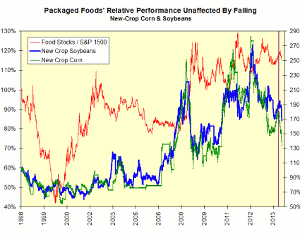You might think the recent drop in raw materials costs would go straight to the food processors' bottom lines, but Howard Simons on Minyanville.com warns you not to think, it'll only hurt the trade.
What happens after the rain makes grain?
Investing often is characterized as being driven by fear and greed; the misguided hopes created by mental linkages and spurious correlation are just as powerful even if they do not fit on a bumper sticker. The big drops in all of the grain prices over the past two months lead many to believe there just has to be a way to trade these commodities via the stocks of food-processing companies.
New crop corn and soybean futures prices have declined 22.75% and 12.25%, respectively, since May 9, 2014, while December wheat futures, a carry from the July new crop, have declined 25.9% over the same period.
You might think this large drop in raw material costs would flow straight to the bottom line of the food processors, a group that includes ConAgra (CAG), General Mills (GIS), Hershey Foods (HSY), Tyson Foods (TSN), and Kraft Foods Group (KRFT).
But as they say in baseball, when you think, you hurt the team. I last looked at this in November 2013 and concluded the following:
The map of relative performance since January 1998 reveals something else: The two periods where Packaged Foods' relative performance increased rapidly were the two great bear markets of 2000-2002 and 2007-2009. Relative performance rose not as a function of these stocks doing absolutely well but rather as a function of other stocks in more discretionary and income-sensitive industries doing poorly.
You have to eat, yes. However, this does not make a generally defensive industry group a good all-weather investment. Finally, if you want to trade corn or soybeans, trade them directly via the futures market and not indirectly in the stock market.
Let's update the chart of the S&P 1500 packaged food group's performance relative to the S&P 1500 Supercomposite itself against the cash market prices for new-crop corn and soybeans. I marked the May 2014 downturn in the grain prices with a vertical line.
The food companies' relative performance actually has declined 1.68% since May 9, 2014. This indicates one of several factors is operating. First, the firms are active hedgers of their raw-food costs, and it would not be surprising at all if they had capped their corn and soybean costs going into the growing season. Indeed, it would have been a dereliction of duty if they had not done so.
Second, the firms' raw materials costs pale in comparison to their other operating costs, such as labor, energy, and marketing. Gone are the days when the box cost more than the cornflakes inside, but corn to Kellogg (K) is not quite the same thing as jet fuel to Southwest Airlines (LUV).
The third factor goes straight to the slow pace of personal income growth. Consumers may not be able to control many key items of their personal budgets, taxes especially, but they can control decisions at the margin in the grocery store. Behavioral economists smile at how people may spend the same amount of time comparing the costs on two frozen pizzas as they will on much bigger-ticket items. It gives us good feeling to make a smart choice, no matter how small that choice is.
There will be many ups and downs in grain prices over the growing season. My advice is, if you want to trade corn, trade corn. Do not trade it in a derivative manner via packaged food equities.
Howard Simons, Contributor, Minyanville.com






















